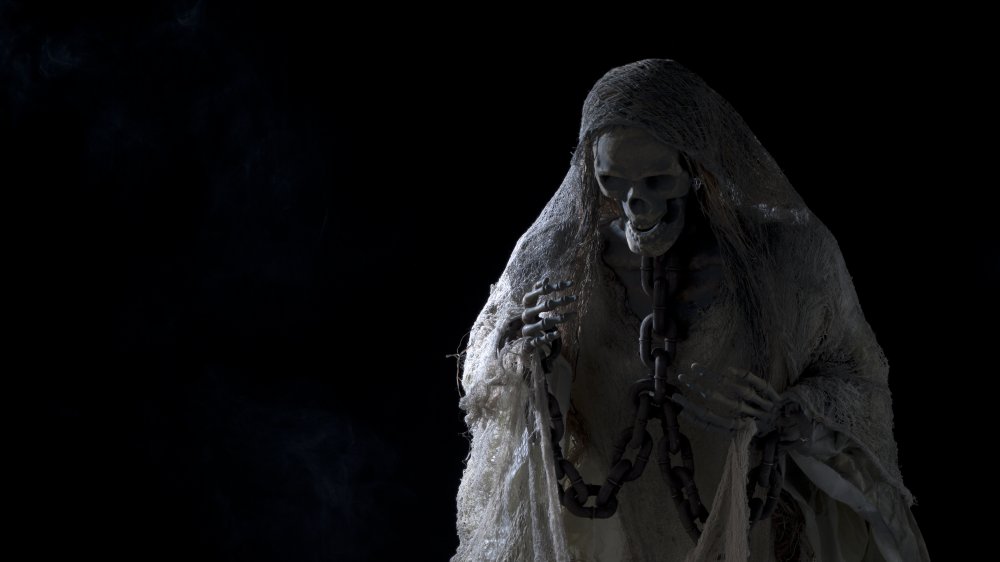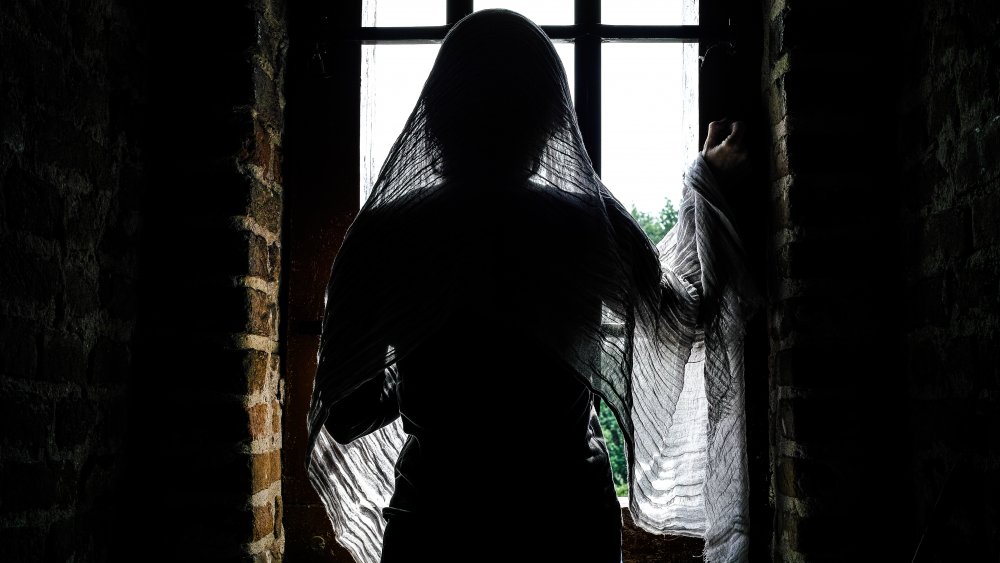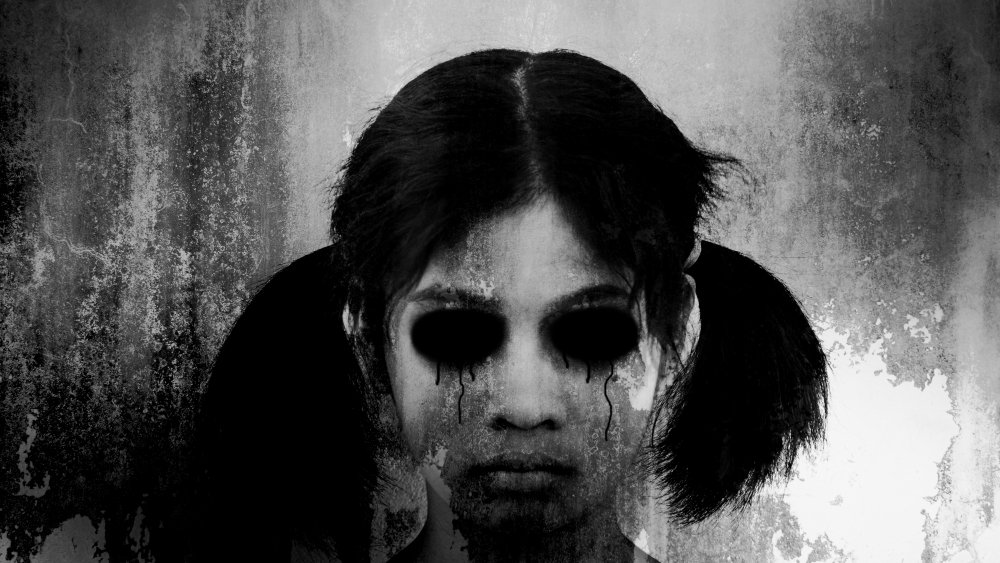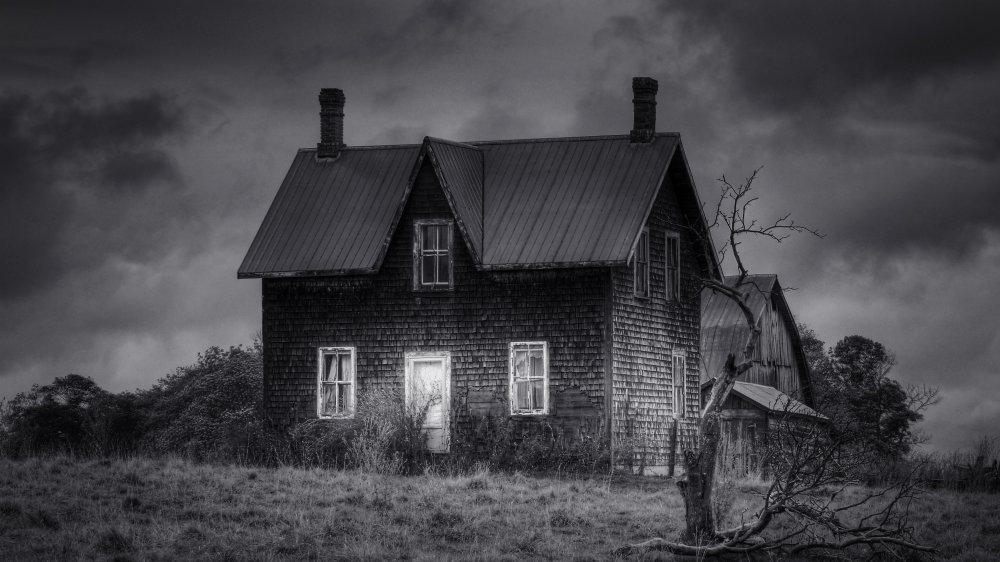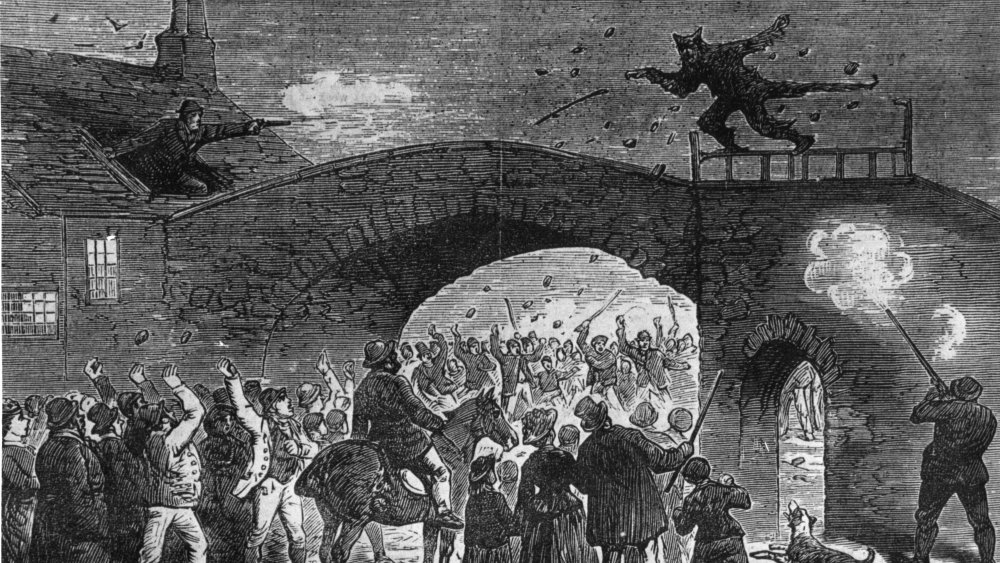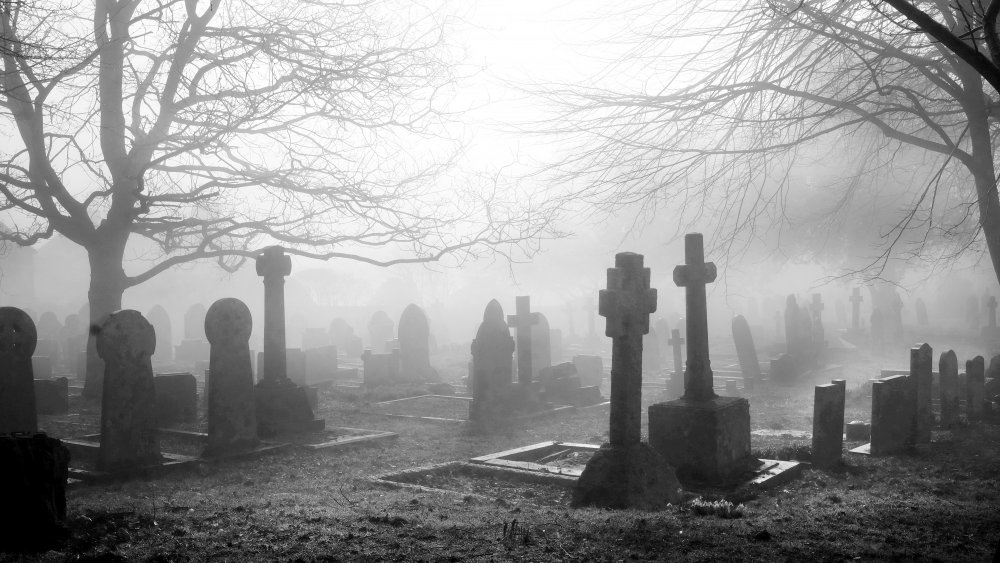Terrifying Incidents That People Blamed On Spirits
Since the first humans huddled around a flickering fire, there have been ghost stories. From the dead coming back to life to spectral, otherworldly figures beyond the mortal plane, ghost stories are a way for people to bridge the gap between life and death. But while ghosts may be incorporeal, that doesn't mean that they aren't dangerous.
When a spirit starts to influence the world around it — rather than merely haunting it — it becomes known as a poltergeist. Poltergeists aren't usually friendly and have been known to attack the residents of homes, throw pots and pans, and even set the home itself ablaze. Sometimes they're even accused of murder. In many scenarios, poltergeists tend to be associated with young women. And, if you don't believe in poltergeists, a sad possibility emerges: The cases are attributable to children who are lost, confused, or potentially being abused and are unable to do anything but act out.
But other scenarios aren't so dire. Sometimes, a regular old murder goes unsolved, and the only answer is "ghosts." Other times, mass hysteria can set in, and multiple people may start to see the same unexplainable ethereal activities. Either way, it's not uncommon for ghosts to be blamed for some pretty terrifying incidents.
A family was tormented for years by the Bell Witch
In 1804, John Bell and his family settled on 320 acres of Tennessee farmland – and for 13 years, nothing happened. But in 1817, family members started to notice the first signs of a haunting.
It all began with strange, ghostly animals lurking around the property. Then came classic poltergeist activity: sounds throughout the house and even a ghostly voice. At first, these were attributed to a neighbor: Kate Batts. While the neighbor denied that she was a part of the haunting, perhaps on account of being alive, the entity became known as "Kate" or the "Bell Witch," perhaps to Kate's chagrin: She was, after all, still their neighbor.
It was reported that the entity seemed to have two reasons for existence: to kill John Bell and to disrupt his daughter, Betsy's, marriage. Bell himself had seizures. Betsy had her hair pulled, skin scratched, and body beaten. What makes the Bell Witch somewhat remarkable is that it was witnessed by others outside of the household.
Ultimately, the Bell Witch haunting culminated in John Bell dying of poisoning at the age of 70, with the Bell Witch a suspect. Per The Tennessean, some theorize that the Bell Witch was nothing more than a cover-up for the abuse of his young daughter and that a slave ultimately poisoned Bell for failing to protect her.
A widow's ghost has murdered men in their sleep — for years
According to the Chicago Tribune, throughout Malaysia, Singapore, and Thailand, multiple men have succumbed to Sudden Unexplained Nocturnal Death Syndrome. Hundreds of such deaths occurred between 1983 and 1990 and were blamed on a widow's ghost — which they attempted to ward off with red nail polish and phallic symbols.
Why a widow? In Thai folklore, widowed ghosts are spirits who committed adultery during their life. Once these widows pass on, they seek vengeance upon men — by luring them into the afterlife. What had likely begun as a justification for wet dreams took a darker turn when villages experienced so many previously healthy men dying. Red T-shirts, red nail polish, and red-tipped phallic symbols are used to ward off the widow's ghost, as a way to indicate that there are no men to kill in the home. But even men with red-painted nails have died.
Medically, some believe that the widow's ghost is likely to be a disease that lurks unidentified and unaddressed, due to the lack of medical access within rural villages. And because rural villages can have genetic bottlenecks, it's easier for these types of diseases to go unchecked. As none of the men who have died were able to be autopsied, though, the "vengeful ghost" can't be disproven. And why not have pretty nails?
The Ghost of Wirral has haunted residents for decades
Since 1939, Wirral has been haunted by the spectral figure of a woman, rumored to be a banshee — a harbinger of death. She has clawed faces, grabbed hair, and even smashed in television sets, per the Wirral Globe. Essentially, it's a lot like the English borough is being haunted by a really, really drunk woman.
Over the decades, the Wirral Ghost has been seen by up to a dozen people at a time. She appears as an eldritch figure with long, black hair covering her face, sometimes singing in the darkness — and for some insane reason, people have reportedly approached her. During perhaps the most bizarre supernatural occurrence, the ghost of Wirral appeared within a family's home, grabbed a picture above their fireplace, and smashed their television set. Maybe she just didn't like what they were watching?
Also known as the Whitehouse Lane ghost, the Ghost of Wirral is sometimes believed to be the spirit of a woman who died while pregnant, with a spectral baby appearing across her abdomen. More specifically, she's a "lady in white": a classic type of ghost with a white dress and black hair that tends to crop up in film, media, and folklore. But no one has been able to determine her real motivation besides just making a lot of people's nights violent and weird.
A young girl was strangled with a curtain during the Enfield Haunting
From 1977 to 1978, 11-year-old Janet was the victim of poltergeist activity. Even police reported seeing unexplained happenings around the household, and multiple people saw and heard an old man's voice emanate from her. But was it a real haunting — or just a hoax?
The Enfield haunting was independently verified, insofar as police did witness activity at the home. Both Janet and her sister report the haunting as being true. But, as noted by Radio Times, some speculate that the girls were just faking it for attention, and even some psychics think it was a hoax.
There are reasons to believe either side. Janet, for instance, was witnessed faking some of the sounds using a broom handle, as well as bending spoons around the property. And the reliability of the eyewitnesses has been called into question, due to the power of suggestion. But though the girls admit that they did fake these things, they insist the haunting itself was real. An argument could be made that they were only trying to get someone to pay attention to them.
Either way, the hoax was compelling enough to inspire The Conjuring 2 – and it remains one of the most popular and famous hauntings today.
Another young girl was beaten by bricks in Jaboticabal, Brazil
So, there's a lot of evidence that the Enfield Haunting was a hoax — because it happened around videotape and tape recorders. It was well-documented. But a lesser-known haunting had a more tragic end.
As told by Occult World, in Jaboticabal, Brazil, stones, eggs, bricks, and crockery began to target an 11-year-old girl named Maria in her home. First, they thought it was a trick. Then, they began to believe Maria was a medium and that these were spiritual attacks. Some even believed her to be a witch. The attacks weren't relegated only to Maria — at one point, a stone struck three people on the head — but they did seem to be centered around her. She was briefly taken in by an occult spiritualist, but they couldn't help her. She was returned to her mother and died at the age of 13, after drinking a glass of pesticide.
By the time of her passing, the girl had been hit by bricks and stabbed by needles. Exorcisms had been performed, and her clothes had caught on fire. But while Maria may have been haunted, much of the phenomenon can also be explained by a disturbed young child — one continually seeking attention and validation from those around her.
The Surrency House experienced constant poltergeist activity
In 1872, the Surrency House experienced classic and violent poltergeist activity: pots and pans flying around, things falling off walls, and unexpected shaking. Of course, the home was by the railroad tracks, but that didn't explain everything. Screams, voices, and footsteps were also heard.
After having objects hurled at them repeatedly, the family sensibly decided to move — but the ghosts followed them until 1877, when the family patriarch died. (And yes, it stands to reason that perhaps the family patriarch was just a very violent man, but the haunting was witnessed by other people.) Some believed that the family itself was cursed, while others believed the family may have been extra-sensitive to the spirits already around them. The farmhouse was a tourist attraction until it burned down in 1925.
Unlike many other haunted homes, there were few theories as to who the poltergeist had "been" before the haunting. The Haunted South: Where Ghosts Still Roam notes that "to this day the ghost of Surrency has never been explained." But one can also note that the "haunted South" tends to crop up on plantations in Southern states: areas where people died en masse.
After a violent attack, Esther Cox was targeted by a vengeful poltergeist
The Amherst Poltergeist is a strange tale that begins with a brutal attack. After Esther Cox was assaulted by a friend of the family, she started experiencing mysterious attacks: cuts, bruises, fever, and even written warnings. It appeared as though the violent attack had drawn the attention of a dark spirit. Esther's body became unexpectedly red and swollen. Noises came from under her bed, plaster was torn from the wall, fires began around the house, slaps appeared on Esther's body, and sewing pins stabbed her.
After Esther was finally stabbed by the poltergeist — a pocketknife being torn away from a neighbor boy and lodging into her back — she moved out of her house. Unfortunately, her misfortune seemed to follow her. After a farm burned down, she was arrested for arson, convicted, and sentenced to four months in jail. Released after a month, she appeared to have finally shaken the spirit. The story would later be recorded in the book The Great Amherst Mystery: An Eyewitness Account of the Most Famous Haunting of the Nineteenth Century.
There are many such tales — and it doesn't go without notice that the victims of poltergeist activity are often young women. Sometimes, poltergeist activity may be explained by violence being otherwise visited upon the young women ... or by violence they visit upon themselves after experiencing a tragic event. But not all hauntings are so personal.
Hundreds of tourists have been attacked by Bloody Mackenzie
As related by The Scotsman, few poltergeists have been as prolific as Bloody Mackenzie. He is said to have attacked 350 people — and caused 170 to collapse — since 1999 alone. At his burial location, tourists are frequently left "bloodied and bruised" by an unseen apparition. The poltergeist is believed to be Judge and Lord Advocate Sir George Mackenzie, an executioner responsible for the deaths of thousands.
Bloody Mackenzie was known to be one of the most vicious prosecutors within the region, allowing guards to beat protesters, executing them, and using their heads to adorn the gate's spikes. In 1679, Mackenzie rounded up 1,200 Covenanters and incarcerated them. Prisoners were subject to starvation and torture. All told, he's said to have killed almost 18,000 individuals in eight years.
So, perhaps it's not a huge leap to imagine that the man would continue to haunt the area after his death. According to the tale, a homeless man was the first to encounter the eerie presence at Mackenzie's burial location: the Black Mausoleum in Greyfiars Kirkyard. Soon after, a visitor was found unconscious, with bruising around her neck. Since then, numerous people have reported assaults at the cemetery.
If that seems like a situation that should be addressed, people have tried — in 1999, minister Colin Grant attempted to perform an exorcism. He died shortly thereafter of a heart attack.
The wraith known as Spring-Heeled Jack haunted Victorian England
Have you ever heard of Spring-Heeled Jack? Every era has its own unique terrors that go bump in the night, but what about something that goes hop, hop, hop? In Victorian England, that was Spring-Heeled Jack. Some believed him to be an imp, some a devil, and still others a ghost.
According to Atlas Obscura, the attacks began as a mysterious figure who would ring a doorbell. When a woman would answer, her clothes would be torn, and sometimes fiery, blue breath would be blown into her face. Often, the women would have seizures, but always the figure would swiftly disappear.
How he disappeared is perhaps the most interesting part of the tale. Spring-Heeled Jack was so named because of how he bounded away like a garish rabbit. Spring-Heeled Jack's legend grew over the years, imagining him as a dark figure with burning eyes. But today, some believe that he was really a sequence of copycats — mischievous men playing a series of gruesome pranks.
A family of six was murdered at the Hinterkaifeck farm
In 1922, a family of six was murdered on a small German farm, as detailed by All That's Interesting. Most of them died instantaneously, though one of them survived for hours after the initial attack — and it appeared as though she had pulled out clumps of her own hair before passing. Even the infant of the family was killed within his crib. While over 100 suspects were interviewed, no murderer was ever discovered. Eventually, fingers were pointed, of course, to a ghost. Much of this relied upon the testimony of a maid, who had quit six months before the murders. She reported hearing voices within the home, even though no one was there.
Many have theories about the Hinterkaifeck murders, but perhaps the most obvious explanation is that a stranger may have been living there, biding their time. Still, there are other theories, primarily based on the fact that the family patriarch and his daughter had been previously accused of incest. The daughter's husband might have come home and killed everyone in a rage. Unfortunately for this theory, the husband was almost definitely killed in action prior to the murders. (But was it his ghost?) Alternatively, the either the patriarch or the daughter may have perpetrated a murder-suicide. But none of the victims had injuries that were self-inflicted.
Later, students in Germany decided to solve the murder using modern forensic skills. They claimed to be certain who the murderer was but didn't release the information.
The Jamison family disappeared during a road trip
There are few things that sound as innocent as a family road trip. But on October 8, 2009, the Jamison family of Oklahoma embarked upon a road trip from which they would never return. Later, their truck would be discovered with all their possessions in it — along with their starving dog. The bodies of Bobby, Sherilynn, and their six-year-old daughter Madyson would be found four years later.
It appeared as though the family had wandered off into the woods — but there was no explanation as to why. Police theorized it had to do with drugs, but it was noted by others that Madyson had been talking to an imaginary friend, and the mother and father believed they were plagued by dark spirits.
According to Medium, video surveillance showed Bobby and Sherilynn loading things into their truck as though they were in a trance. The family's storage container had been covered with graffiti, and it was reported that the mother of the family had claimed to be a witch. Theories emerged: They could have been members of a satanic cult, victims of spiritual warfare, or simply on drugs. Others believed that they simply got lost by the side of the road, pulled over to orient themselves, and never found their way back.
What about people murdered because someone thought they were a ghost?
So far, we've seen a lot of people getting attacked and dying and having it blamed on ghosts. But an incident happened in Hammersmith that was almost the perfect inverse.
In December 1803, the residents of Hammersmith started to witness a ghost. Per Medium, this specter was said to be cloaked in white, with horns and large glass eyes. On top of that, while walking through a churchyard, a man named Thomas Groom was accosted by a dark figure and choked into unconsciousness. There was a significant amount of rumor around the town regarding the origin of the ghost, but no one really knew where it may have originated. Still, the sightings continued — until a night patrol ended in tragedy.
At the churchyard, Thomas Millwood was fatally shot. A patrolman had assumed that he was the ghost. It was a perfect storm: He hadn't responded when called out to, he was out late at night (to pick up his wife), and he habitually wore all white. It was the traditional garb of a plasterer by trade. The patrolman who shot him, Francis Smith, was tried for murder in 1804. He was sentenced to death but was saved before execution and instead spent a year in prison.

